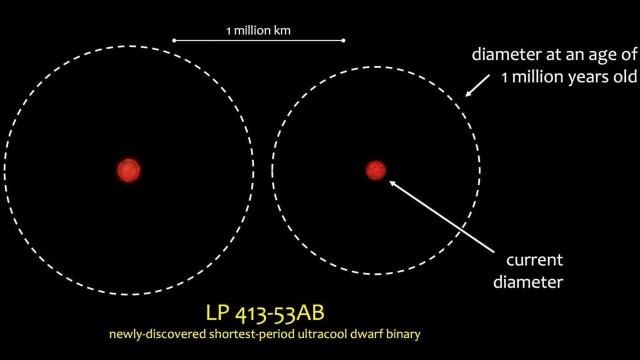Researchers have found an extreme binary system that features two dwarf stars that are so cool, they don’t emit visible light. And they’re so close together that they take less than one Earth day to orbit around each other.
The system is called LP 413-53AB, and it was identified by researchers from Northwestern University and the University of California San Diego. The two dwarf stars are in a class known as ‘ultracool’ — their temperatures are so low that they emit mostly infrared light, rendering them invisible to our eyes (but thankfully not our telescopes). Chih-Chun “Dino” Hsu, an astrophysicist at Northwestern University, led the study and presented the findings at the American Astronomical Society meeting in Seattle this week.
“It’s exciting to discover such an extreme system,” said Hsu in a statement. “In principle, we knew these systems should exist, but no such systems had been identified yet.”
Hsu and his colleagues discovered LP 413-53AB while combing through archived data. Since the stars are locked together by each other’s gravity so tightly, the light emitted from the system appeared to the researchers as one star, until further investigation revealed two separate stellar bodies. The dwarf stars are low in mass and orbit around each other in just 20.5 hours.
Hsu and his colleagues decided to observe the system directly using the W.M. Keck Observatory in Hawaii. The research team’s first observation was only two hours long in March 2022, before they conducted followup observations in July, October, and December.
“When we were making this measurement, we could see things changing over a couple of minutes of observation,” Adam Burgasser, an astrophysics professor at UC San Diego and a collaborator on this research, said in the release. “Most binaries we follow have orbit periods of years. So, you get a measurement every few months. Then, after a while, you can piece together the puzzle. With this system, we could see the spectral lines moving apart in real time. It’s amazing to see something happen in the universe on a human time scale.”
Hsu, Burgasser, and their colleagues found that the distance between the two stars is about 1% of the distance between Earth and the Sun, and they speculate that the stars could have migrated toward each other over their lifespans. LP 413-53AB is also estimated to be billions of years old and has one of the shortest orbital periods ever detected for a binary star system.
Let LP 413-53AB serve as an example of a friendship that has only grown closer with age.
